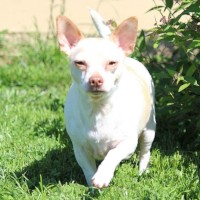Appearance of the Bullhuahua Terrier
|
| Bullhuahua Terriers have a robust, muscular body and a Chihuahua head, including the breed's characteristic pricked ears. They are longer than they are tall and tend to be the size of miniature Bull Terriers, weighing between 9 and 13.5 kilos and measuring between 25 and 35.5 centimeters in height. The extent of coat variation within each parent breed explains the Bullhuahua Terrier's wide range of colors. Their short, smooth coats can be blue (gray), black, chocolate, cream, fawn with tan and white markings. Depending on the color of the Bull Terrier parent, however, they may also have a substantial white covering or even a brindle pattern. Bullhuahua Terriers have medium-length tails and compact, round legs. They have an intuitive, intelligent expression, with round, distant eyes and an often black nose. |
Temperament of the Bullhuahua Terrier
|
| Bullhuahua Terriers are known for being courageous, lively and protective pets. They are bold but sensitive animals who bark occasionally and aren't afraid to speak up if they feel alarmed or threatened. They can also be hostile and lively towards children and other dogs, so it's best to make new introductions slowly. They are quite active for small dogs and require regular exercise to stay fit and healthy. Bullhuahua Terriers who take after their Bull Terrier parents may also need vigorous playtime with their owners or other dogs. Above all, this breed is a people-oriented pet. If left alone for long periods, they can be destructive and indignant. Bullhuahua Terriers are happiest when in the company of their family, and tend to develop a strong attachment to one person in a household. Note that the Bullhuahua Terrier will be more difficult to train and housebreak than many other breeds. As such, early and diligent training is an important part of raising a well-bred Bullhuahua Terrier. |
Needs and activities of the Bullhuahua Terrier
|
| The Bullhuahua Terrier is a moderately energetic breed that requires regular but modest exercise to stay healthy. Bullhuahua Terriers that take after their Bull Terrier parent may be more energetic. In any case, this breed is suitable for all climates and domestic environments if it has a place to walk or play outdoors, such as a park or yard. This breed can be hostile to other animals and children, so it should not be off-leash until the owner can make an informed decision based on its personality. Although owners must be diligent in exercising their Bullhuahua Terriers to avoid weight gain and health problems, they are primarily indoor dogs and prefer to spend time with family members. |
Maintenance of the Bullhuahua Terrier
|
| Bullhuahua Terriers are not hypoallergenic dogs, making them unsuitable for owners with allergies. Because of their short, smooth coats, Bullhuahua Terriers don't require much grooming, and aren't even prone to shedding. These dogs should only be bathed when necessary, so that their coat retains its natural oils and shine. Owners should pay particular attention to keeping Bullhuahua Terriers' big ears clean. In addition, owners may choose to brush them from time to time with a firm bristle brush to remove dead hairs. Bullhuahua Terriers should also have their nails trimmed 1-2 times a month to prevent painful overgrowth or nail fractures. Like all breeds, Bullhuahua Terriers need their teeth brushed every day. |









 English (United Kingdom)
English (United Kingdom)